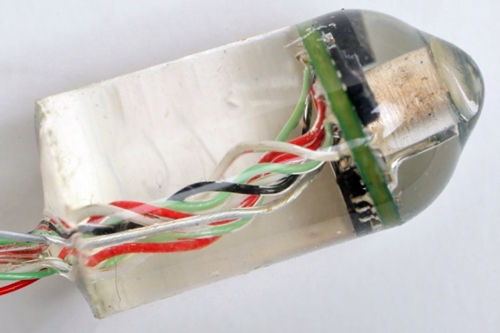
Ingestible electronic device that measures heart and respiratory rates (Albert Swiston, MIT Lincoln Laboratory)
19 November 2015. Engineering and medical researchers developed and tested in pigs a swallowed capsule with sensors that records heart and respiratory rates in real time. The team from the bioengineering lab of Robert Langer and Lincoln Laboratory at Massachusetts Institute of Technology published its proof-of-concept results yesterday in the journal PLOS One.
The technology from the MIT team, with colleagues from Massachusetts General Hospital, is designed to address a need for measuring vital signs in burn or other trauma patients or in settings where regular health monitors are impractical, such as soldiers in combat. Vital signs sensors packed into a capsule could also improve health monitoring of people with chronic diseases and training of elite athletes.
Current technologies for monitoring vital signs require devices that come into contact with the skin, such as pulse oximeters or electrocardiograms, which can be difficult for burn patients. Wearable monitors are also available, but they can be uncomfortable or add weight and bulk, which would discourage their use by athletes. Plus, current ingestible devices are designed to monitor the digestive tract, not heart and breathing rates.
For this technology, the researchers adapted the principle of a stethoscope, a device that listens in on heart and respiratory rates. The team combined a tiny microphone with signal processing components that identify background noises in the digestive tract, then separate the resulting acoustic wave into heart beats or lungs inhaling and exhaling. For this study, the device is packed into a silicone capsule about the size of a multi-vitamin tablet and wired to an endoscope. A second microphone is placed over the heart.
The researchers tested the device with 6 anesthetized pigs, who were fed the capsule either when fasting or after taking food, both solid and liquid. “Through characterization of the acoustic wave, recorded from different parts of the GI tract,” says first author Giovanni Traverso in a university statement, “we found that we could measure both heart rate and respiratory rate with good accuracy.” Traverso is a gastroenterologist at Massachusetts General Hospital, and a researcher affiliated with MIT.
Among the limitations noted by the authors are differences in transit time through the gastrointestinal tract, with the best results noted in the upper tract — esophagus to the small intestine. Another issue was ambient noise, both internal and external, which the team believes can be addressed with more sophisticated signal processing algorithms. The researchers next want to develop the device further making a completely wireless system from FDA-approved materials.
Traverso and senior co-author Robert Langer founded the company Lyndra Inc. in Cambridge, Massachusetts to commercialize technology that extends the release of oral medications to one week. While the company is not working on ingestible diagnostics or vital signs monitoring, many aspects of its technology, including testing with pigs, are similar to the methods used in the study.
Senior co-author Albert Swiston and Traverso tell more about the device in the following video.
- Nanotech Sensors Devised for RNA Cancer Detection
- Smartphone Add-On Found Comparable to Pro Stethoscopes
- Wearable Asthma Trigger Detector in Development
- Faster Process Devised for Skin-Patch Sensors
- Mobile App Collecting Placenta Health Data
* * *

 RSS - Posts
RSS - Posts
[…] Vital-Signs Sensors Built Into Ingestible Capsule […]